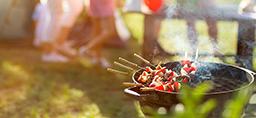
Paddling the Muskegon River one summer day, gastroenterologist Michael Puff, MD, looked up in alarm to see his 5-year-old son slurp a handful of water from the river.
“What are you doing? You can’t drink that!” he said.
Too late. Bacteria in the water led to painful cramps and diarrhea for the poor kid several days later.
His son (now a healthy adult) learned a lesson many grown-ups learn every summer: Some nasty bugs love the warm weather as much as we do.
As people gather to play and cook and eat in the lovely, lazy days of summer, food safety experts warn picnickers to watch out for uninvited guests at the table.
They aren’t talking about odd relatives. They mean microbes with nausea-inducing names—like campylobacter, the bacteria that made Dr. Puff’s son sick.
Warm weather, the right food, the wrong storage methods and lack of hand-washing can create a recipe for food poisoning.
The results range from mild discomfort to a trip to the emergency department for a life-threatening illness, said Jessica Corwin, MPH, RDN, a dietitian and community nutrition educator.
She urges people to follow food safety precautions, even if they ignored them in the past and didn’t feel any ill effects. Not everyone responds to infections the same way. Those most at risk of serious complications include small children, pregnant women, the elderly and those with compromised immune systems.
“If you are going to a large picnic or group gathering, you don’t know who is going to be there,” she said. “If we all do our part, we know we are going to help those other people.”
The culprits
Three factors make outdoor food safety challenging:
- Warm temperatures foster bacteria growth.
- Outdoor play plus limited access to soap and water means more dirty hands involved in food prep.
- Cooks must prepare and store food without the conveniences of a home kitchen, such as a refrigerator or oven with a set temperature.
Records show five organisms account for about 90 percent of foodborne illnesses in the U.S., Dr. Puff said.
Norovirus towers over them all: It’s to blame for 20.9 million reported cases of illness last year.
Salmonella caused about 1.2 million cases. Campylobacter and clostridium perfringens caused about 2.2 million cases. Other common culprits are staphylococcus aureus, E. coli and shigella.
In most cases of infection, the patient feels miserable. They vomit, have diarrhea and suffer severe abdominal pain.
But usually they can take care of the symptoms at home. Dr. Puff advises those with foodborne illness to push fluids to prevent dehydration and to eat bland foods. The BRAT diet—bananas, rice cereal, applesauce and toast—is a good starting point. He also suggests a little Imodium for low-grade symptoms.
For those with more severe symptoms, such as bloody diarrhea, fever or signs of dehydration, Dr. Puff advises going to the doctor or emergency department.
Practical prevention tips
The best approach to foodborne illness, however, is prevention.
Corwin suggests 8 practical tips to ensure everyone goes home from the picnic with only fond memories:
1. Pack bleach wipes and hand sanitizer. Even if the restroom lies a few hundred yards away, you can still keep your hands clean. When Corwin gives cooking demonstrations, she stops to wash her hands whenever she touches raw meat, fish or poultry, her hair or even her clothing.
2. After preparing a dish at home, cool it first in the refrigerator before you pack it in the cooler. Make sure the cooler has enough ice or cold packs to keep the food at 40 degrees or colder. Or consider a cooler that plugs into a car’s AC adapter.
3. Separate foods so there is no cross-contamination. Raw meat, seafood and poultry should remain in separate packages from ready-to-eat foods. If possible, put them in a cooler separate from your beverages and snacks.
4. Use a meat thermometer to make sure food on the grill reaches the right temperature. Experienced grillers know to insert it in the thickest part of the meat, without touching the bone. Because that can be hard to gauge, Corwin checks several spots.
5. Once you put the meat on the grill, wash the plate, fork and tongs in soapy water before using them again. No place to wash? Bring two sets of platters and utensils, so the raw meat won’t contaminate the cooked product.
6. Be especially careful with potluck dishes made with dairy or eggs. You can put a small bowl of potato salad in another bowl of ice. When the salad runs low, place the bowl aside and swap in a freshly filled bowl, refreshing the ice below as well.
7. Remember the maxim, “When in doubt, throw it out.” Corwin urges diners not to take a chance with a questionable item, particularly on a sweltering summer day, when ice melts quickly.
8. Consider bringing a dish with minimal risk, such as cut-up fruits and vegetables, salsa and chips, hard cheeses and dried meat. Create a nut butter and jelly bar, where diners can try different flavored nut butters combined with honeys and various kinds of jam.
 /a>
/a>
 /a>
/a>
 /a>
/a>